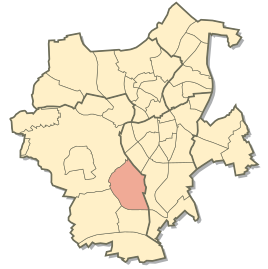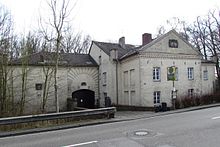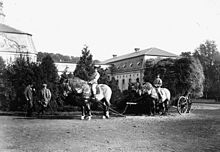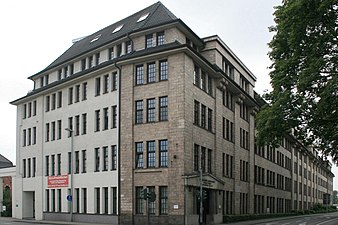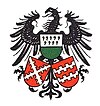Wickrath
|
Wickrath
City of Mönchengladbach
|
|
|---|---|
| Coordinates: 51 ° 7 ′ 43 " N , 6 ° 24 ′ 39" E | |
| Height : | 35 m above sea level NHN |
| Area : | 6.41 km² |
| Residents : | 17,286 (March 31, 2012) |
| Population density : | 2,695 inhabitants / km² |
| Incorporation : | 1st January 1975 |
| Postal code : | 41189 |
| Area code : | 02166 |
|
Location of Wickrath in the West district of Mönchengladbach
|
|
|
Wickrath Castle
|
|
Wickrath is part of the western district of Mönchengladbach and was an independent municipality in the Grevenbroich district until the regional reform . On January 1, 1975, it was incorporated into the municipality as part of the merger of Mönchengladbach with Rheydt .
structure
The districts of Wickrath-Mitte, Wickrath-West , Wickrathhahn , Wickrathberg , Buchholz , Beckrath , Herrath and Wanlo belong to the former municipality .
On December 31, 2018, 17,188 residents lived in the Wickrath district, distributed among the districts of the former municipality as follows:
- Wickrath-Mitte = 10,376 inhabitants
- Wickrath-West = 3453 inhabitants (with Buchholz, Beckrath, Herrath, Wickrathhahn)
- Wickrathberg = 2242 inhabitants
- Wanlo = 1117 inhabitants
The postcode of Wickrath is 41189. Until the introduction of the five-digit postcodes, the name was 4050 Mönchengladbach 4, before the municipal reform the postcode was 4072.
history
prehistory
Stone Age traces have been discovered in Wickrathberg and Wanlo. Especially after the last Ice Age, at the end of the Paleolithic Age (11700-9600 BC), people lived in the Wanlo area, not far from the numerous sources of the Niers. Decorated ceramic vessels, dating from 5000 to 2000 BC BC, have been found in this area as well.
Roman times
The area of today's Wickrath was already settled in Roman times around 200 AD. There are numerous ruins in the area of today's Wickrath, Wickrathberg , Wanlo, Beckrath, Buchholz and Wickrathhahn. These ruins were probably all farms ( Villa rustica ) that supplied the Roman village ( Vicus Mülfort ) and the Roman camps on the Rhine, only a few kilometers away . These farms were destroyed by the attack of the Franks in 274 AD.
Franconian time
It was not until the 9th and 10th centuries that the area was rediscovered and settled by the Franks crossing the Rhine , presumably at the same time as Dahlen , Holzweiler , Borschemich and Beckrath and Herrath , and immediately later Wickrathberg . Two Franconian tribes settled left and right of the Niers. People of the Salian tribe lived in Wickrath and the Ripuarian Franconian tribe in Wickrathberg . According to the latest investigations, the earliest written mention of the place name Wickrath is not proven by documents from 961 and 1068, both of which are forgeries, but only for the years 1104/1105. At this time, a Count Gerlach, the owner of Wichinrod Castle, appeared in the life story of the Archbishop of Cologne, Anno II . This castle may have been where the castle is today, and it was a moated castle. Furthermore, Gerhard I was also mentioned here as the first ruler over Wickrath from the Hostaden house (Hochstaden).
In 1166 the lord of the castle Otto I died and with him the old Hochstadens. The eldest son Dietrich, who called himself Count von Ahre - Hochstaden, inherited the title. His son Otto I kept the title of Herr von Wickerode . As early as the 12th century, the Wickrath rule included the main town, the villages Wickrathberg, Beckrath, Herrath and the areas of Wickrathhahn and Buchholz, which were newly settled in the 12th and 13th centuries, as well as parts of Hockstein, Mennrath and Wetschewell. In addition to this area, the Counts of Hochstaden-Wickrath also owned the Hamborn Monastery near Duisburg as well as other free float. The Schwanenberg rule with the main town and the settlements Lentholt, Genhof and part of Genfeld remained - with one interruption - an incorporated part of the Wickrath rule. From 1200 to 1205 he had the Romanesque church built in Wickrath. In 1205 the small parish church of Wickrath was consecrated as the Salvator Church. In 1418 it got a larger nave and was decorated with the altar of St. Consecrated to Anthony.
In 1309 the Hochstaden family died out and Wickrath fell to the Counts of Geldern. As a result, the castle was often lent to different owners until the 15th century.
In 1363 the Lohmühle, formerly a castle mill , was mentioned for the first time. Originally it was a grain mill, later an oil mill.
Old Wickrath was once surrounded by a wall, a moat and a rampart and had an upper and lower gate, and a third gate was added later on Schaumburggasse. Within the walls, the place called Freiheit Wickrath, the surrounding land, as far as it belonged to the rulership, was called Glory . According to a document from 1363 one spoke of a fortress and in 1436 of "the Vestinge von Wikerode".
In the Middle Ages, only the area around the castle and church belonged to the freedom of Wickrath. Beckrath, Herrath, Wickrathberg, Wickrathhahn, parts of Buchholz, Hockstein, Mennrath and Wetschewell, as well as the exclave Schwanenberg, between Erkelenz and Wegberg, also belonged to the Wickrath rule.
In 1482 Wickrath received town and market rights
In 1482, Archduke Maximilian von Habsburg conquered Wickrath Castle with an armed hand and handed the castle and town over to his friend and advisor Heinrich von Hompesch. Heinrich v. Hompesch came from the Rhenish nobility and not only had important estates in the Duchy of Jülich, he also held two of the highest hereditary state offices there as hereditary steward and marshal. In 1488 Wickrath became a town freedom . This became possible because Maximilian I. Wickrath raised to imperial direct rule and handed over the fief to the knight Heinrich von Hompesch . Wickrath belonged to the Lower Rhine-Westphalian Empire . At the same time, the area of Wickrath receives city and market rights.
In 1491 Heinrich von Hompesch's wife founded the Kreuzherrenkloster or Kreuzbrüderkloster. Through his Latin school in Wickrathberg, Wickrath became known beyond the borders. After the death of Heinrich von Hompesch, around 1502, the Wickrath inheritance went to the stepsons, the later Counts of Quadt. The gender of the Quadt-Wickrath is initially assigned to the Rhenish knight circle and. They converted to the Protestant faith in the middle of the 16th century. The small baroque church in Wickrathberg , first mentioned in 1220, became Protestant in 1529. The monastery with the Romanesque church remained in the possession of the Catholic Cross Lords.
Johann von Quadt has been named as Herr von Wickrath since 1568. He took the parish church from the Order of the Knights of the Cross, which, however, was fought back by the Knights of the Cross eleven years later.
In 1586 Wanlo was ambushed and looted by 200 marauding mercenaries. 13 houses and the church were set on fire.
In 1620 the von Quadt was officially raised to imperial barons.
Constant raids and sieges in the 16th, 17th and 18th centuries
At the beginning of the Eighty Years 'War (1568–1648), during the Spanish-Dutch War and the Thirty Years' War (1618–1648), Spanish troops invaded Wickrath several times. In 1568 there was even a siege in neighboring Dahlen, the Battle of Dahlen . After the Peace of Westphalia in 1648, Wickrath did not come to rest. From 1650 to 1655, Geldrian foot troops and cavalry, who were on the Catholic, Spanish side, marched again into Wickrath. There were sanctions, arrests and looting. This was repeated in 1659 and 1660. But other soldiers and troops from the Protestant side also invaded Wickrath. Swedish soldiers came in 1633, troops from Brandenburg in 1677/78, 1696 and 1698, troops from the Bishop of Münster in 1678 and troops from Braunschweig-Lüneburg and Hanover in 1703 and moved into their winter quarters in Wickrath. Because of his barony, Wickrath was politically weak and a cheap sacrifice. Furthermore, imperial troops moved into Wickrath in 1632, 1635 and 1763. Wickrath Castle was destroyed several times in individual raids.
Teutschhaus as an alternative village name for Wickrath
In the period of the 16th and 18th centuries, numerous maps differentiated between Wickrath Castle and the village of Wickrath, which was known as the Teutschhaus. The name Teutschhaus cannot be found in documents and church registers. The reason for the alternative village name is unknown. It is speculated that the historical-geographic writer Matthias Quad from Wickrathberg , who between 1592 and 1604, published maps and books under the name Kinckelbach , including the book Teutscher Nation Herligkeit (Teutscher Nation Herligkeit ), such as his hometown Wickrath, related to the Order of the Crosses belonged, clarified better or made it look more powerful.
Tensions between the Catholic population and the Reformed lords of the castle
In the 17th and 18th centuries there was greater tension against the Catholic population of Wickrath, due to the reformed authorities of Wickrath. In 1700 the Electoral Palatinate intervened and invaded Wickrath. In at least one case, troops from the Electorate of Cologne invaded the rule in the middle of the 18th century in order to militarily protect a Catholic procession against hindrances of the Wickrath sovereign.
In 1724 Freiherr Friedrich Wilhelm Quadt had freedom laid out behind the upper gate by drawing out some house squares. The result is today's Quadtstraße, which the citizens called Neustadt.
Construction of Wickrath Castle (1746–1772)
In 1745, Wickrath Castle was largely destroyed by fire. This suited Otto Wilhelm von Quadt's new building plans. In 1746 and 1772, Wickrath Castle was built on the foundations of the demolished castle . The castle was built as a baroque complex based on the model of French castles .
In 1752 Wilhelm Otto Friedrich von Quadt, the builder of Wickrath Castle, bought himself the elevation to imperial count . He spent 20,000 guilders in fees and bribes , which considerably exceeded his sovereign annual income.
French period (1794-1813)
In 1794 the lords of the castle fled across the Rhine from the advancing French. The imperial immediacy of Wickrath actually ended with the occupation by Napoleon's troops . The castle served as an imperial French stallion depot. In 1801 the left Lower Rhine became the Département de la Roer and thus part of the French Republic. All counts who were directly involved in the Reich were compensated for their losses in the Reichsdeputationshauptschluss . The Counts of Quadt were assigned the Imperial Abbey of Isny and the previously imperial city of Isny in the Allgäu as a newly formed Imperial County.
In the 1812 Russian campaign under Napoleon, Wickrather were also involved as soldiers. In 1813 the French withdrew completely from today's territory of Germany after the Battle of Leipzig . Wickrath came to Prussia . The castle was converted into a cavalry barracks. However, this was dissolved in 1834 due to frequent fever cases. In Prussia, the municipality Wickrath belonged since 1813 to the district of Grevenbroich in the administrative district of Dusseldorf .
Industrialization and various new buildings by Wickrath (1839–1927)
In 1839 the outer bailey was converted into a state stud, which existed until 1955. In 1852 the Wickrath station was opened with the rail connection from Aachen via Gladbach to Düsseldorf. There was an industrial boom in Wickrath. The Wickrath leather factory was founded in 1855 by Zacharias Spier. In 1859 the main building of the baroque palace had to be demolished because it was completely neglected and allegedly dilapidated. In 1860 the synagogue in Wickrathberg was rebuilt. In 1905 the tram to Rheydt was opened, in 1907 the route to Wickrathberg was extended. In 1907, Wickrath received permission from the Düsseldorf district government to build a hospital. In 1908 a waterworks was built in Wickrath. In May 1925, the Wickrath open-air swimming pool was opened to the public. In 1927 the fire fighting equipment and training house with a large riser tower was inaugurated.
Important buildings and monuments in Wickrath
Wickrath at the time of National Socialism
In 1934 Wanlo and Wetschewell were incorporated.
In 1936 the Nazi authorities took action against the owner of the Wickrath leather factory for foreign currency offenses and attempted tax evasion. Due to the growing pressure, the Spier family left Germany.
The synagogue in Wickrathberg was completely destroyed during the Reichspogromnacht staged by the National Socialists . All Jewish shops in Wickrath were destroyed by the mob . SA people in civilian clothes also entered the homes of Jewish residents and devastated them. 50 Jewish men were arrested in Gladbach, Rheydt and Wickrath. From 1939 the Jewish families still living in Wickrath and Wickrathberg were concentrated in so-called Jewish houses . The last 40 people affected were deported from here .
The second World War
The Second World War caused great damage in Wickrath. On October 8, 1944, a driverless German fighter plane, the pilot of which was fatally wounded, hit the top of the church tower of Wickrath's parish church, destroying the tower hood, including the weather valve , cross and ball. The plane crashes on the corner of Friedhofsweg / Mühlenweg (now Antoniushügel / Untertor).
On February 26, 1945, Wickrath, which had been only a few kilometers from the front on the Rur for a few months, experienced an air raid. On the advice of Pastor Heinrich Lohmann , some people fatally seek shelter from the bombs in the basement of the rectory. The parish church, the rectory, the vicarie , the youth home and de Hött were destroyed. In addition to the pastor, chaplain Wilhelm Esser and a Swiss churchman whose body was only recovered from the rubble after a year, 19 Wickrath citizens died. A Catholic war pastor was the only one to escape the inferno. A lava- tuff grotto at the entrance to the cemetery at the parish church also fell victim to this attack .
In the last days of the war, the US armed forces built the nine square kilometer Wiesenlager Wickrathberg prison camp between Mongshof, Wickrathberg and Hochneukirch , which was later under the command of the British armed forces. At least 150,000 German soldiers lived there when fully occupied. The soldiers spent the entire time in terrible conditions in the open air and mostly slept in holes they had dug themselves. The food was very sparse. The exact number of fatalities is unclear, witnesses said 20 deaths a day, others a total of 226 deaths. The camp existed from April to September 1945.
On August 15, 1954, the foundation stone was laid for the new St. Antonius Church, the consecration of which was celebrated on September 22 and 23, 1956.
Incorporation into the city of Mönchengladbach (1975)
Against the fierce resistance of the Wickrath municipal council, the municipality of Wickrath was incorporated into the new city of Mönchengladbach on January 1st, 1975. Not only did the previous postcode (4072) and the vehicle registration number (GV for Grevenbroich district) change, but also many street names had to be changed because there were already streets with the same name in Mönchengladbach or Rheydt:
| Before 1975 | From 1975 |
|---|---|
| Main road | Quadtstrasse |
| Rheydter Strasse | Gelderner Strasse |
| Odenkirchener Strasse | Hochstadenstrasse |
| Fliethstrasse | Op de Fleet |
| Bismarckallee | Trumpeter Alley |
| In the corner | At the Lohmühle |
Restoration of the original castle complex and renaturation of the Niers (since 2002)
In the run-up to the state horticultural show in 2002, the outer bailey, the bridges and the park were extensively renovated, the castle was repainted in the original, ox blood red color. In the same year the Horse Center Schloss Wickrath was established when the Rhenish Horse Studbook moved its headquarters from Bonn to Schloss Wickrath . In parallel to the preparatory work for Euroga, the Niers Association is tackling the project of renaturation of the Niers .
In October 2009 the city council decided to reduce the number of districts Mönchengladbach to four. This resulted in a merger for Wickrath with the Rheindahlen district to form the West district. The 10th district of Wickrath becomes Mönchengladbach West. Rheindahlen, Holt, and Hehn also belong to the new city district.
Population numbers
- In 1900 Wickrath had 5,877 inhabitants, of which 2,860 were Catholics, 2,796 Protestants and 183 Jews.
- In 1919 Wickrath had 6,447 inhabitants.
- On May 17, 1939, the community of Wickrath had 8,642 inhabitants.
- On September 13, 1950, Wickrath had 10,158 inhabitants.
- On June 6, 1961, Wickrath had 12,051 inhabitants.
- On May 27, 1970 Wickrath had 12,893 inhabitants. Thereof 6,134 males and 6,758 females.
- On December 31, 1980, Wickrath had 15,060 inhabitants - Wickrath Mitte 8,847, Wickrath-West 2,978, Wickrathberg 2,190 and Wanlo 1,045 inhabitants.
- On December 31, 1990, Wickrath had 15,335 inhabitants - Wickrath Mitte 8,753, Wickrath-West 3,179, Wickrathberg 2,334 and Wanlo 1,059 inhabitants.
- On December 31, 2004, Wickrath had 18,220 inhabitants - Wickrath Mitte 10,981, Wickrath-West 3,754, Wickrathberg 2,274 and Wanlo 1,211.
- On December 31, 2009, Wickrath had 17,585 inhabitants - Wickrath Mitte 10,547, Wickrath-West 3,664, Wickrathberg 2,185 and Wanlo 1,189.
politics
Wickrath coat of arms
| Blazon : “Combined coat of arms of black eagle and three applied shields, the two lower ones inclined. The upper one divided into silver (with ermine tails) and green, the left one with a silver, serrated St. Andrew's cross on red; the right divided into three by two silver alternating battlements on red. " | |
|
Justification of the coat of arms: The Wickrath coat of arms is a composite coat of arms consisting of a black eagle and three shields, of which the two lower ones are inclined. The upper shield is divided into two parts. The upper half is silver with ermine tails , and the lower half is green. The left shield shows a silver, serrated St. Andrew's cross on a red background. The right shield is also red and is divided into three by two silver battlements. All four components symbolize families that were owned by the Wickrath rule. Until 1310 it belonged to the Counts of Are-Hochstaden as a Geldrisches fief . Suggesting their name, they had the eagle (Aar) in their coat of arms. In 1335 the Geldrian count enfeoffed Lord von Broichhausen , traditionally from Broekhuizen , a place in the Dutch municipality of Horst aan de Maas , with Wickrath. On the right eagle catch is the coat of arms of the Hompeschs; In 1488 they were enfeoffed with Wickrath by the emperor , d. In other words, the former Geldrian rule of Wickrath became imperial and thus an independent territory. As a result, the Lords of Hompesch became Imperial Barons to Wickrath. From 1502 until Wickrath was taken over by the French in 1796, the Lords of Quadt were in the feudal possession of the free rule of Wickrath. Her pinnacle coat of arms lies on the eagle's left muzzle. The overall coat of arms of Wickrath is not without its charm; It is particularly noticeable that it does not have the usual shield shape, but rather an eagle coat of arms. This eagle is that of the Are family and must not be misinterpreted as a Prussian or imperial eagle , for example because of Wickrath's former imperial immediacy; since 1909, the municipalities were forbidden to use these eagles in their coats of arms.
The Wickrath coat of arms was designed in 1926, shortly before the mayor's office was declared office (1927). Its creator was Professor Otto Hupp . |
mayor
- 1800-1802 nn. Azevedo (as Maire )
- 1802–1809 Johann Heinrich Quast (as Maire )
- 1808–1813 Leonhard Engels (as Maire )
- 1813–1816 Franz Schaumburg (until 1814 as Maire )
- 1816–1856 Wilhelm Valentin Denhard
- 1856–1883 Hugo Naegelée
- 1884–1919 Wilhelm Kloeters
- 1919 - March 1945 Karl Dißmann
- 1945 - January 1946 Franz Otten
- 1946 - April 1946 Gottfried Corsten
- 1946 - October 1947 Josef Sommer
- 1947 - October 1948 Karl Dißmann
- 1948 - November 1950 Hermann Schagen
- 1950 - November 1951 Willi Dörges
- 1951 - October 1952 Heinrich Gerhards
- 1952 - November 1954 Willi Dörges
- 1954 - April 1961 Heinrich Sattelmeyer
- 1961 - September 1968 Gustav Karsch
- 1968 - December 1969 Theodor Müller
- 1969 - April 1970 Heinz Trauten
- 1970 - December 1974 Konrad Bäumer
Community directors
- 1946 - March 1948 Matthias Raaf
- 1948 - August 1950 Karl Dißmann
- 1950 - February 1963 Karl Eßer
- 1963 - December 1974 Wolfgang Krane
District administration manager
- January 1, 1975 to February 2004 Hans-Josef Pisters (also registrar )
- March 2004 to April 2005 Annemarie Beiten-Abrahams
- April 8, 2005 to October 22, 2009 Michael Oehlers
- October 21, 2009 to August 31, 2014 Ludwig Geilen
- from September 1, 2014 Heiko Heisters
District head
- 1975–1989 Konrad Bäumer (CDU)
- 1989–1999 Friedel Coenen (SPD)
- 1999–2009 Marianne Beckers (CDU)
- from November 10, 2009 Arno Oellers (CDU)
Rheindahlen and Wickrath have been part of the West District since 2010.
traffic
Road traffic
The village of Wickrath is affected by the A 61 motorway. There are a total of three motorway junctions: MG-Wickrath (13), MG-Wickrathberg (14) and MG-Wanlo (16). The Wickrath junction leads to the center and the MG-Wickrath industrial park. The Wanlo motorway junction is located in the southeast of Wickrath. The A 61 and the A 46 cross here .
Bus transport
The bus traffic in Wickrath is carried out by NEW mobil and aktiv Mönchengladbach . Line 006 and the express bus SB1 connect Wickrath with Rheydt and Mönchengladbach city center, line 006 also connects the villages of Wickrathberg and Wanlo in the south of Wickrath to the center of Wickrath. Line 016 runs from Wickrath-West with the villages of Wickrathhahn, Beckrath, Herrath and Buchholz via Wickrath and Rheydt to Korschenbroich . Line 026 connects to Odenkirchen or Rheindahlen and Hardt . The Wickrath, Markt stop serves as the central transfer point between the lines .
Wickrath train station
The Wickrath stop on the Aachen – Mönchengladbach railway line, opened as a train station in 1852 , is served hourly by the Rhein-Niers-Bahn between Essen Central Station and Aachen Central Station.
Culture and sights
buildings
- Wickrath Castle with its park as part of the Route of Garden Art between the Rhine and Maas
- Schlossbad Niederrhein (formerly: Wickrather Schlossbad) on Wickrathberger Strasse. The new building was opened in February 2008 and is intended to attract bathers from all over the region as a fun pool.
- Jewish cemetery on the Roßweide. The grave of Gretel Spier, which was created around 1936/37 by the sculptor Leopold Fleischhacker , can also be found here.
- Schlossmühle Wickrath former Lohmühle on Hochstadenstrasse / Schlosspark. Now used as living space.
- Wickrather Lederfabrik industrial monument, rededicated as a residential and commercial building complex in 1999, while retaining the architectural features and the historic street front.
- Wickrath water tower ; The tower, built in 1912 and 55 m high, was in operation until 1979. Since 1979 it has not been used. In 2006 the tower hood with the water tank was removed. The not listed water tower was demolished in January 2012.
Events
- Up until 2010, Wickrath Castle was the venue for the Castle Park Tournament for 25 years .
- The pageantry (Schützenfest) takes place three weeks after Pentecost every year.
Club life
- The Rheinisches Pferdestammbuch association is housed in the east wing of Wickrath Castle. He has set himself the goal of reviving Wickrath Castle as the center of Rhenish horse breeding. From 1892 to 1911, the Rhenish Horse Studbook was located in Wickrath Castle. Furthermore, the Warendorf State Stud, founded in 1826 as the Royal Prussian-Rhenish-Westphalian State Stud , was housed in the palace complex until 1957 . The Rheinisches Pferdestammbuch association has around 5000 members and looks after 8000 breeding horses from 50 different horse breeds.
- The Wickrather Schützengesellschaft von 1967 e. V. St. Antonius has been a member of the Federation of Historic German Shooting Brotherhoods since 2006.
- District association Mönchengladbach-Rheydt-Korschenbroich
- TuS 1860 e. V. Wickrath
- Fistball department
- HSG DJK TUS Wickrath Handball
schools
- Wickrath Community Primary School (Kreuzherrenstr. 17, 41189 Mönchengladbach)
- Realschule Wickrath (Kreuzhütte 24, 41189 Mönchengladbach)
Well-known Wickrather
- Ernst von Schaumburg (* 1807 in Wickrath; † October 10, 1882 in Düsseldorf), German officer and historian.
- Johanna Ey (born March 4, 1864 in Wickrath; † August 27, 1947 in Düsseldorf ), gallery owner; A memorial was erected in Wickrath in her honor.
- Karl-Hans Laermann (born December 26, 1929 in Kaulhausen, residing in Beckrath), was Federal Minister of Education and Science (FDP) from February 4, 1994 to November 1994
- Michael Cramer (born March 1, 1930 in Wickrath; † November 28, 2000 in Munich), film actor and voice actor.
- Günter Seuren (born June 18, 1932 in Wickrath; † December 10, 2003 in Munich), writer.
- Reinhard Baumhögger (* 1946), head of the Arcadia Hotels group of companies
- Rebecca Gablé (Ingrid Krane-Müschen; born September 25, 1964 in Wickrath), writer ( The Settlers of Catan ).
- Ulla Lenze (born September 18, 1973), writer.
- Ina Menzer (born November 10, 1980 in Atbasar, Kazakhstan ), boxer.
literature
- Joseph Husmann, Theodor Trippel: History of the former glory resp. Imperial Counties and the Wickrath Parish. Part 1 + 2, 1909-1911.
- Günter Krings: The imperial immediacy of Wickrath 1488–1794. On the early modern constitutional and regional history of a small Lower Rhine territory in the German Empire. In: Annalen des Historisches Verein für den Niederrhein 206 (2003), pp. 95–128.
- Wolfgang Löhr: Mönchengladbach-Wickrath. Series: Rheinische Kunststätten, 255. Ed. Rhenish Association for Monument Preservation and Landscape Protection. Neusser Druckerei & Verlag, Neuss 1981 ISBN 3-88094-390-7 .
- Wolfgang Löhr: Rhenish city atlas : Wickrath . Landschaftsverband Rheinland , 2nd edition 1998.
- Wickrath in old views. Edited by Heimat- und Verkehrsverein, Wickrath 1982.
- Michael Marx: History of the former glory resp. Imperial Counties and the Wickrath Parish. Part 3: 1900-1974. Local and tourist association, Wickrath 1996.
- Wilhelm Kuhlen: Forays through the history of the Wickrath rule. Heimat- und Verkehrsverein, Wickrath 1988.
- Karl-Heinz Schumacher: Wickrath Castle. A castle complex on the Lower Rhine in old and new pictures. Heimat- und Verkehrsverein, Wickrath 2003, ISBN 3-00-012882-4 .
Web links
Individual evidence
- ↑ The population of the city of Mönchengladbach at the location of the main residence by districts and districts on December 31, 2018. Retrieved November 4, 2019 .
- ↑ Wolfgang Löhr (Ed.): Small Mönchengladbach City History . Pustet, Regensburg 2009, Regensburg 2009, ISBN 978-3-7917-2226-9 , pp. 15 .
- ^ Wolfgang Löhr with the support of the Sparkasse Foundation for Art and Science, the Reiners Foundation GmbH and the Josef and Hilde Wilberz Foundation (ed.): Loca Desiderata, Mönchengladbacher Stadtgeschichte . tape 1 . Rhineland publishing and operating company of the Rhineland Regional Association, Brauweiler Abbey, Pulheim 1994, ISBN 3-7927-1375-6 , p. 253-267 .
- ^ A b c Rhineland Regional Association (ed.): Rheinischer Städteatlas Wickrath . Landschaftsverband Rheinland, 1978, ISBN 3-7927-0438-2 (category: II / II topography).
- ↑ Lothar Hericks: village history. In: heimatverein-wickrathberg.de. October 12, 1930, Retrieved November 4, 2019 .
- ^ Wolfgang Löhr with the support of the Sparkasse Foundation for Art and Science, the Reiners Foundation GmbH and the Josef and Hilde Wilberz Foundation (ed.): Loca Desiderata, Mönchengladbacher Stadtgeschichte . tape 1 . Rhineland publishing and operating company of the Rhineland Regional Association, Brauweiler Abbey, Pulheim 1994, ISBN 3-7927-1375-6 , p. 438 .
- ^ Wolfgang Löhr with the support of the Sparkasse Foundation for Art and Science, the Reiners Foundation GmbH and the Josef and Hilde Wilberz Foundation (ed.): Loca Desiderata, Mönchengladbacher Stadtgeschichte . tape 1 . Rhineland publishing and operating company of the Rhineland Regional Association, Brauweiler Abbey, Pulheim 1994, ISBN 3-7927-1375-6 , p. 237-267 .
- ↑ a b c d e f g h i j k l m n o p q r s t u v w x y z aa ab ac ad ae af Wickrath history - Heimatverein Wickrath.
- ↑ a b c d page 7, commemorating the day the bombs fell ( Memento from February 15, 2015 in the Internet Archive ) (PDF) - Our Wickrath.
- ↑ a b c d e f City Chronicle of Mönchengladbach ( Memento from October 1, 2013 in the Internet Archive ) (PDF) - City of Mönchengladbach.
- ↑ Research 2014 in the Mönchengladbach City Archives - Michael Ritz
- ↑ Wolfgang Löhr with UntersSBN = 3-7927-1375-6 (Ed.): Loca Desiderata, Mönchengladbacher Stadtgeschichte . tape 1 , p. 438 .
- ↑ a b Jewish communities - Mönchengladbach - Heimatverein Wickrath.
- ^ Heinz-Josef Katz: POW camp. The chronicler, accessed on November 12, 2011 .
- ^ Federal Statistical Office (ed.): Historical municipality directory for the Federal Republic of Germany. Name, border and key number changes in municipalities, counties and administrative districts from May 27, 1970 to December 31, 1982 . W. Kohlhammer, Stuttgart / Mainz 1983, ISBN 3-17-003263-1 , p. 291 .
- ↑ Wickrath Chronicle Part 1 . Heinz-Josef Katz. October 15, 2011. Retrieved May 12, 2012.
- ↑ Water tower: hood off - that's it . Westdeutsche Zeitung - Local - Mönchengladbach - Mönchengladbach current
- ^ Inge Schnettler: Mönchengladbach: Castle Park Tournament at the end. In: rp-online.de. July 15, 2012, accessed September 2, 2014 .
- ↑ primary schools. In: Mönchengladbach.de. Retrieved May 13, 2016 .
- ↑ Realschulen. In: Mönchengladbach.de. Retrieved May 13, 2016 .

